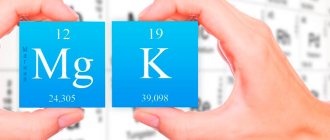special instructions
Due to the fact that the components of the drug are vulnerable to the aggressive environment of gastric juice and pancreatic enzymes, it is recommended to take Panangin simultaneously with food. This will ensure that the acidity of the stomach is reduced, and most of the enzymes will be occupied with the breakdown of fats and proteins contained in food, which will ensure that potassium and magnesium enter the intestinal lumen, from where the substances are absorbed into the blood.
Taking Panangin should be accompanied by regular blood tests so that the doctor can monitor the content of potassium and magnesium in the cells. This will avoid hyperkalemia and other negative consequences of overdose.
Panangin in the treatment of cardiovascular diseases
Potassium and magnesium deficiency is observed in patients with heart disease, type 2 diabetes mellitus (DM), chronic alcoholism, genetic forms of kidney loss of potassium and magnesium (Gitelman and Bartter syndrome), severe diarrhea and vomiting, malnutrition, taking certain drugs [1,4,5]. Potassium and magnesium are intracellular cations that play a major role in the functioning of many enzymes, the interaction of macromolecules and intracellular structures, and in the mechanism of muscle contractility. The intra- and extracellular ratio of potassium, magnesium, calcium and sodium ions affects myocardial contractility. Low levels of potassium and/or magnesium ions in the internal environment can have a proarrhythmic effect [6–8], predispose to the development of arterial hypertension (AH) [9–11], atherosclerosis of the cerebral and coronary arteries [12,13], and the occurrence of endothelial dysfunction ( due to the production of nitric oxide and participation in platelet aggregation), type 2 diabetes and metabolic changes in the myocardium [1,14]. One of the most important physiological functions of potassium is maintaining the membrane potential of neurons, myocytes and other excitable structures of myocardial tissue. Potassium is the main intracellular cation in tissues of various organs. Under normal conditions, the cell contains 150–160 mmol/l, and the blood serum contains 3.5–5.5 mmol/l. Potassium ions (K+) are involved in the formation of cellular action potentials (depolarization and repolarization phases), transmission of nerve impulses, contraction of cardiomyocytes, skeletal and smooth muscle fibers, and regulate and maintain the functions of the urinary system. An imbalance between intra- and extracellular potassium content leads to a decrease in the contractility of smooth muscle fibers and myocardium, the occurrence of arrhythmia, tachycardia and increased toxicity of cardiac glycosides [10]. The daily potassium requirement of an adult is 40–100 mmol/l. The causes of hypokalemia are associated with insufficient intake of potassium from food (improper and “fast” nutrition), increased removal from the body (vomiting, diarrhea, uncontrolled use of diuretics), increased blood pressure (primary hyperaldosteronism, renovascular hypertension, long-term use of corticosteroids), increased potassium consumption by tissues (insulin administration, excess catecholamines) [13]. Magnesium is a cofactor in more than 300 enzymatic reactions of energy metabolism and the synthesis of proteins and nucleic acids, reduces contractile tension and heart rate, leading to a decrease in myocardial oxygen demand, and has an anti-ischemic effect on myocardial tissue [15]. A decrease in the contractility of smooth muscle myocytes in the walls of arterioles, including coronary ones, leads to vasodilation and increased coronary blood flow [16,17]. Magnesium deficiency is associated with increased levels of total cholesterol, low-density lipoproteins, triglycerides, decreased activity of lecithin-cholesterol-aminotransferase and lipoprotein lipase, and increased activity of HMC-CoA reductase [18–20]. Magnesium deficiency leads to a decrease in cell resistance to free radical processes in the body, which underlie oxidative stress and atherosclerosis - the main links in the development of CVD [2,12,20]. The prescription of magnesium-containing drugs is especially justified for long-term use of cardiac glycosides, which provoke hypokalemia and subsequent rhythm disturbances, including those associated with a deficiency of this ion in patients with chronic heart failure (CHF). Panangin contains potassium and magnesium ions and affects metabolic processes. The combination of potassium and magnesium ions in one preparation (Panangin) is justified by the fact that potassium deficiency in the body is often accompanied by magnesium deficiency and requires simultaneous correction of the content of both ions in the body. When correcting the levels of these cations, an additive effect is observed, in addition, potassium and magnesium reduce the toxicity of cardiac glycosides without affecting their positive inotropic effect. The concentration of magnesium (Mg++) in blood serum is 0.65–1.1 mmol/l, in erythrocytes – 1.65–2.55 mmol/l. The daily requirement of an adult for magnesium is 25–35 mmol/l [21]. Panangin (Gedeon Richter, Hungary) is available in film-coated tablets (or in dragee form), containing 0.158 g of potassium aspartate (36.2 mg of potassium) and 0.140 g of magnesium aspartate (11.8 mg of magnesium), and also in the form of an injection solution in 10 ml ampoules containing 0.452 g of potassium aspartate (103.3 mg of potassium ion) and 0.40 mg of magnesium aspartate (33.7 mg of magnesium). Indications for use of Panangin: arrhythmias caused by hypokalemia, hypokalemia due to taking saluretics. The drug is prescribed as part of complex therapy for heart failure, myocardial infarction, cardiac arrhythmias (mainly ventricular arrhythmias); to improve the tolerability of cardiac glycosides; for metabolic syndrome (obesity, hypertension, impaired glucose tolerance, type 2 diabetes), to compensate for the deficiency of potassium and magnesium when their content in the diet is reduced. Magnesium deficiency is associated with impaired glucose tolerance, and magnesium preparations can correct this condition. The drug is taken orally, 1-2 tablets. (dragée) 3 times/day. The maximum daily dose is 3 tablets. 3 times/day. Panangin should be taken after meals, because the acidic environment of the stomach contents reduces its effectiveness. The duration of therapy and the need for repeated courses are determined by the doctor individually. Panangin is also prescribed intravenously as a slow infusion to relieve an attack of arrhythmia in urgent situations [22,23]. Single dose - 1-2 ampoules (diluted in 50-100 ml of 5% glucose solution or isotonic sodium chloride solution), if necessary, repeated administration can be done after 4-6 hours. For slow intravenous administration, 1-2 ampoules of Panangin can be diluted (10 –20 ml) in 250–500 ml of the same solutions and injected dropwise. For example, a solution of potassium and magnesium aspartate (aspartate) was successfully used to prevent atrial fibrillation after coronary artery bypass surgery [24]. Aspartic acid transports magnesium ion across the cell membrane and promotes its absorption. Panangin does not have a cumulative effect and has a limited list of relative contraindications for use: hyperkalemia, acute or chronic renal failure (oliguria, anuria), heart rhythm disturbances in combination with degree II-III atrioventricular block, acute metabolic acidosis, hypovolemia (dehydration), Addison's disease, individual hypersensitivity to the components of the drug. A meta-analysis of 19 studies (including 586 people, 412 of them with hypertension) showed a relationship between the severity of the hypotensive effect and the duration of potassium supplementation. An average reduction in blood pressure of 5.9/3.4 mmHg was demonstrated. when using tableted potassium preparations [9]. During long-term observation (on average 6.7 years) of 7563 patients with hypertension, of which 1679 received diuretics, it was noted that the resulting hypokalemia (potassium concentration less than 3.5 mmol/l) was accompanied by an increase in the incidence of cardiovascular complications [10]. It is advisable to assess changes in the concentration of potassium in the blood in parallel with the quantitative assessment of magnesium indicators, because it is an important component for the absorption of potassium and ensuring its optimal intracellular level. Combined potassium and magnesium deficiency can lead to hypokalemia that is resistant to treatment if magnesium deficiency is not simultaneously corrected [12]. It is believed that magnesium ions inhibit the activity of the renin-angiotensin-aldosterone system and, with their deficiency, more favorable conditions are created for systemic vasoconstriction. When Panangin is used simultaneously with potassium-sparing diuretics and ACE inhibitors, the risk of developing hyperkalemia increases (the level of potassium in plasma should be monitored). When using this drug, discomfort or burning in the stomach is possible in patients with hypoacid gastritis and cholecystitis. It is necessary to observe a three-hour interval between taking Panangin orally. With hypokalemia, nausea, vomiting, diarrhea, and paresthesia are possible. With hypermagnesemia, the following symptoms are observed: facial flushing, thirst, decreased blood pressure, hyporeflexia, respiratory depression, and convulsions [18]. Calcium supplements reduce the effect of magnesium supplements. Astringents and enveloping agents reduce the absorption of the drug in the gastrointestinal tract and reduce adverse reactions. Plasma magnesium levels below 0.76 mmol/l are considered a significant risk factor for stroke and myocardial infarction. The European Epidemiological Study on Cardiovascular Diseases identified hypomagnesemia as an important risk factor for death from stroke and CVD [25]. A recently completed study found a significant reduction in the risk of sudden cardiac death with increasing serum magnesium levels, independent of other factors such as hypertension, diabetes, potassium levels, heart rate, and a history of coronary artery disease. It has been established that low serum magnesium levels are an important predictor of sudden cardiac death (234 cases of sudden death were recorded in a cohort of 14,232 people aged 45–64 years (average follow-up 12 years) [8]. In relation to hypertension and coronary heart disease, a relationship was also previously established with serum magnesium concentration, rather than with its intake [12]. Thus, it is extremely important to compensate for potassium and magnesium deficiency in patients at risk of stroke, especially those with concomitant heart disease [26, 27]. Panangin, containing potassium aspartate and magnesium aspartate, improves metabolism in the myocardium, increases the tolerance of cardiac glycosides in patients with CHF, has antiarrhythmic activity and can be used for prophylactic purposes and in supportive combination therapy of patients with cardiovascular pathology. Literature 1. Iezhitsa IN, Spasov AA Potassium magnesium homeostasis: physiology, pathophysiology, clinical consequences of deficiency and pharmacological correction // Usp Fiziol Nauk. 2008. Vol. 39(1). R. 23–41. 2. Shilov A.M., Melnik M.V., Osiya A.O., Knyazeva S.A. Treatment of cardiovascular diseases in the practice of a primary care physician: the place of potassium and magnesium preparations (Panangin) // Russian Med. magazine. 2012. No. 3. pp. 102–106. 3. Weglicki WB, Mak Iu.T., Chmielinska JJ et al. The role of magnesium deficiency in cardiovascular and intestinal inflammation // Magnes Res. 2010. Vol. 23(4). R. 199–206. 4. Lucker PW, Witzmann HK Influence of magnesium and potassium deficiency on renal elimination and cardiovascular function demonstrated by impedance cardiography // Magnesium. 1984. Vol. 3 (4–6). R. 265–273. 5. Kramer JH, Spurney C, Iantorno M et al. Neurogenic inflammation and cardiac dysfunction due to hypomagnesemia // Am J Med Sci. 2009. Vol. 338(1). R. 22–27. 6. Eisenberg MJ Magnesium deficiency and sudden death // Am Heart J. 1992. Vol. 124. R. 544–549. 7. Zehender M., Meinertz T., Just H. Magnesium deficiency and magnesium substitution. Effect on ventricular cardiac arrhythmias of various etiology // Herz. 1997. Vol. 22 (suppl 1). R. 56–62. 8. Peacock JM, Ohira T., Post W. Serum magnesium and risk of sudden death in the Atherosclerosis Risk in Communities (ARIC) Study // Am Heart J. 2010. Vol. 160(3). R. 464–470. 9. Cappucio F., McGregor G. Does potassium supplementation lower blood pressure? A meta-analysis of published trials // J Hypertens. 1991. Vol. 9. R. 456–473. 10. Cohen HW, Madhavan S., Alderman MH High and low serum potassium associated with cardiovascular events in diuretic–treated patients // J Hypertens. 2001. Vol. 19 (7). R. 1315–1323. 11. Peacock JM, Folsom AR, Arnett DK et al. Relationship of serum and dietary magnesium to incident hypertension: the Atherosclerosis Risk in Communities (ARIC) Study // Ann Epidemiol. 1999. Vol. 9(3). R. 159–165. 12. Amighi J., Sabeti S., Schlager O. et al. Low serum magnesium predicts neurological events in patients with advanced atherosclerosis // Stroke. 2004. Vol. 35(1). R. 22–27. 13. Kotova O.V. Prevention of strokes: unaccounted opportunities // Russian Med. magazine. 2012. No. 10. pp. 514–516. 14. Kao WH, Folsom AR, Niero FJ et al. Serum and dietary magnesium and the risk for type 2 diabetes mellitus: the Atherosclerosis Risk in Communities Study // Arch Intern Med. 1999. Vol. 159. R. 2151–2159. 15. Ueshima K. Magnesium and ischemic heart disease: a review of epidemiological, experimental, and clinical evidence // Magnes Res. 2005. Vol. 18 (4). R. 275–284. 16. Ukholkina G.B. The role of magnesium in diseases of the cardiovascular system // Russian Med. magazine. 2011. No. 7. pp. 476–479. 17. Sjogren A., Edvinsson L., Fallgren B. Magnesium deficiency in coronary artery disease and cardiac arrhythmias // J Intern Med. 1989. Vol. 226(4). R. 213–222. 18. Abbott LG, Rude RK Clinical manifestations of magnesium deficiency // Miner Electrolyte Metab. 1993. Vol. 19. R. 314–322. 19. Shechter M. Does magnesium have a role in the treatment of patients with coronary artery disease? // Am J Cardiovascular Drugs. 2003. Vol. 3 (4). R. 231–239. 20. Altura BM, Shah NC, Jiang XC et al. Magnesium deficiency upregulates serine palmitoyl transferase( SPN 1 and SPT 2) in cardiovascular tissues: relationship to serum ionized Mg and cytochrome C // Am J Physiol Heart Circ Physiol. 2010. Vol. 299(3). R. 932–939. 21. Chakraborti S., Chakraborti T., Mandal M. et al. Protective role of magnesium in cardiovascular disease: a review // Mol Cell Biochem. 2002. Vol. 238. R. 163–179. 22. Kuhn P., Oberthaler G., Oswald J. Anti-arrhythmia effectiveness of potassium-magnesium-aspartate infusion // Wien Med Wochenschr. 1991. Vol. 141(3). R. 64–65. 23. Manz M., Susilo R. Therapy of cardiac arrhythmias. Clinical significance of potassium–and magnesium aspartate in arrhythmias // Fortschr Med Orig. 2002. Vol. 120(1). R. 11–15. 24. Piper SN, Kiessling AH, Suttner SW et al. Prevention of atrial fibrillation after coronary artery bypass graft surgery using a potassium–magnesium–aspartate solution (Inzolen) // Thorac Cardiovasc Surg. 2007. Vol. 55 (7). R. 418–423. 25. Schimatschek HF, Rempis R. Prevalence of hypomagnesemia in an unselected German population of 16,000 individuals // Magnes. Res. 2001. Vol. 14 (4). R. 283–290. 26. Postnikova S.L., Kasatova T.B., Vereshchagina G.S., Malysheva N.V. Magnesium and cardiovascular diseases // Russian Medical Journal. 2007. No. 20. pp. 1498–1500. 27. Shivakumar K. Pro-fibrogenic effects of magnesium deficiency in the cardiovascular system // Magnes Res. 2002. Vol. 15 (3–4). R. 307–315.
Is it possible to combine Panangin and Riboxin?
It is necessary to combine medications with caution, having first consulted with your doctor. Riboxin, in addition to increasing cell metabolism and improving the absorption of drugs and other elements into the heart tissue, also enhances myocardial contraction. Taking them together can have a beneficial effect - potassium and magnesium best penetrate the fibers of the heart muscle. On the other hand, this may require adjustment of the dosage of Panangin to ensure that the required amounts of potassium and magnesium are not exceeded, in order to eliminate hyperkalemia.
Tachycardias: the same, but different
The myocardium consists of two types of cells - typical, which only contract, and atypical. The latter perform a function unusual for muscle cells: an electrical impulse appears in them, which is transmitted further along the conduction system of the same cells and ensures contraction of the heart chambers. Large collections of such cells are called nodes.
Heart rate can accelerate any element of the cardiac conduction system
The main elements of the conduction system are, in descending order:
- sinoatrial node (it is also called the pacemaker, since normally the heart contracts precisely at its command) - it is located above the right atrium;
- atrioventricular node (or AV node) - a collection of atypical myocardial cells at the border of the atria and ventricles;
- His bundle is a group of cells that transmit impulses from the AV node to the ventricles through Purkinje fibers.
Each of these elements has its own electrical activity, which is why a variety of tachycardias arise: an increase in heart rate (HR) can occur at any stage of the impulse. Therefore, all tachyarrhythmias (disorders of the heart rhythm according to the type of acceleration) are divided into two groups depending on the source of impulse generation:
- 1 Supraventricular - the impulse is born in the atria or above the His bundle (in the sinoatrial or atrioventricular node).
- 2
Ventricular - the source of the impulse is the bundle branches, Purkinje fibers or working ventricular myocardium.
The group of supraventricular tachycardias includes sinus tachycardia. This is the only physiological type of heart rate acceleration that occurs during stress, in children and pregnant women. All other supraventricular and ventricular types of tachycardia do not occur normally
In pathological types of tachycardia, the source of rhythm becomes another element of the conduction system, which generates impulses with a frequency greater than the sinus node
Supraventricular tachycardia
Sinus tachycardia
Rhythm Source:
sinus node. It can be physiological, but it can also be pathological - with it the heart still works rhythmically, but too quickly (more than 100-120 beats per minute).
Symptoms:
chest pain, difficulty breathing, dizziness. Sometimes it is asymptomatic.
Treatment:
physiological variants do not require therapy. For pathological variants, before starting treatment, it is recommended to reconsider your lifestyle: increase the amount of fluid consumed, increase physical activity and limit the use of substances that stimulate the heart (coffee, strong tea, tobacco, alcohol, medications). Beta-blockers and calcium channel antagonists are used as therapy. Such tachycardia does not pose a significant danger to life.
Atrial tachycardia
Rhythm Source:
Most often, the impulse occurs in the right atrium near the mouths of blood vessels and heart valves, between the sinus and atrioventricular nodes.
Symptoms:
increased heart rate up to 150-200 beats per minute, shortness of breath, discomfort and pain in the heart area, sometimes fainting.
Treatment:
vagal techniques (stimulation of the vagus nerve, which reduces the heart rate), intravenous administration of antiarrhythmic drugs. In patients with unstable blood circulation, synchronized electrical pulse therapy can be performed (cardioversion-defibrillation - exposure to the myocardium with electric current, after which the rhythm of cardiac activity is set by the sinus node).
Atrioventricular tachycardia
Rhythm Source:
AV node. The impulse can travel down to the ventricles, up to the atria, or in both directions simultaneously.
Symptoms:
shortness of breath, sweating, dizziness up to the point of lightheadedness and fainting, pain and/or discomfort in the heart area, a feeling of pulsation in the vessels of the neck and “shivering of the shirt” - strong contractions of the myocardium that can be transmitted through the chest to clothing.
Treatment:
vagal techniques, intravenous administration of antiarrhythmics. Cardioversion-defibrillation, installation of a pacemaker, as well as catheter ablation (a microsurgical procedure for influencing an arrhythmically active area of the myocardium with radio frequencies; performed using catheters inserted into the heart through blood vessels) may be necessary.
Atrial tachycardias are detected in patients with coronary artery disease, hypertension, anatomical heart valve defects, myocarditis and cardiomyopathies, that is, they are almost never found in people with a healthy heart.
The danger of supraventricular tachycardia is that, against the background of the underlying heart pathology, tachycardia can develop into atrial fibrillation, a life-threatening condition.
Ventricular tachycardia
Rhythm Source:
electrical impulses circulating inside the ventricle that do not allow the myocardium to relax, causing it to contract repeatedly more often than the atria.
Symptoms:
difficulty breathing, pain in the heart, loss of consciousness, in severe cases - the development of cardiogenic shock with a sharp drop in blood pressure until circulatory arrest. Heart rate is 100-250 beats per minute.
Treatment:
intravenous administration of antiarrhythmic drugs, often radiofrequency catheter ablation of the arrhythmically active area. When circulatory arrest occurs, electrical stimulation of the heart is used. Often the only effective treatment is the installation of a cardioverter-defibrillator.
Ventricular tachycardia with a high degree of probability can transform into ventricular fibrillation. Because of this, this type of heart rate acceleration has an extremely adverse effect on life prognosis.
Ventricular tachycardia occurs against the background of chronic diseases of the cardiovascular system and can lead to sudden cardiac death.
Contraindications to taking the medicine
The drug is not recommended in the following cases:
- renal failure;
- drop in blood (systolic) pressure below 90 mmHg. Art.;
- decreased secretion of adrenal hormones;
- muscle weakness syndrome (myasthenia gravis);
- burn disease (with hyperkalemia);
- 3rd degree impulse conduction block;
- acute period of peptic ulcer and pancreatitis;
- with individual intolerance.
There are no sufficient studies on side effects in children, so most often Panangin is not prescribed for children under 12 years of age.






